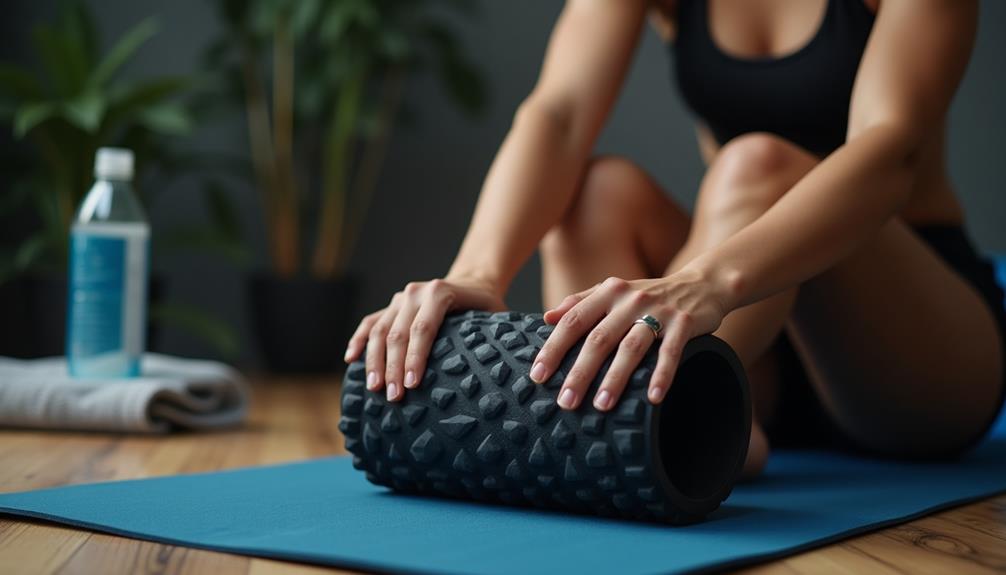To recover effectively, focus on hydration, nutrition, and physical techniques. Hydrate regularly, considering coconut water for electrolytes. Nutritional recovery involves consuming carbs and protein post-workout to replenish glycogen stores. Stretching, both static and dynamic, helps improve flexibility. Foam rolling enhances blood flow and reduces soreness. Engage in active recovery with light exercises like jogging or swimming. Implement ice bath therapy to minimize soreness. Use compression gear to aid circulation, and don't underestimate massage therapy for relieving tension. Finally, practice mindfulness to reduce stress and enhance overall well-being. Keep following for additional insights.
Core Insights
- Hydrate regularly and replenish electrolytes with fluids like coconut water to support muscle recovery after endurance activities.
- Incorporate a balanced post-workout meal of carbohydrates and protein to replenish glycogen stores and promote muscle repair.
- Utilize foam rolling and stretching techniques to enhance flexibility, reduce soreness, and improve blood circulation post-exercise.
- Prioritize 7 to 9 hours of quality sleep each night to optimize recovery and overall athletic performance.
- Engage in mindfulness practices such as deep breathing or meditation to alleviate stress and enhance recovery efficiency.
Hydration Practices

Hydration practices are essential for endurance athletes looking to optimize recovery and performance. To start, understand your fluid needs. During prolonged exercise, you lose water and electrolytes through sweat. Replenishing these is vital. Aim to drink regularly, not just when you're thirsty. Coconut water is an excellent natural option for hydration, offering high potassium content and minimal added sugars. Some brands even provide additional vitamins and electrolytes to support post-workout recovery.
Before your workout, hydrate well. A good rule of thumb is to drink about 17-20 ounces of water two to three hours beforehand. During exercise, sip on a sports drink or water every 15-20 minutes. Afterward, replace lost fluids; aim for about 16-24 ounces for every pound lost during training.
Nutritional Recovery

Nutritional recovery plays an essential role in helping endurance athletes bounce back after intense training sessions. Post-exercise nutrition should focus on replenishing glycogen stores and repairing muscle tissue. Aim for a combination of carbohydrates and protein within 30 minutes after your workout.
Here's a quick reference table to guide your nutritional choices:
| Food Item | Carbs (g) | Protein (g) |
|---|---|---|
| Banana | 27 | 1 |
| Greek Yogurt | 10 | 15 |
| Chocolate Milk | 30 | 8 |
| Quinoa | 39 | 8 |
| Whole Grain Bread | 15 | 4 |
Always listen to your body and adjust your intake based on your training intensity. Proper nutrition fuels your recovery and prepares you for your next challenge.
Stretching Techniques

Incorporating effective stretching techniques into your recovery routine can greatly enhance flexibility and reduce muscle soreness. Stretching helps improve blood flow and prepares your muscles for the next workout. For deeper muscle relief, contemplate utilizing foam rollers for self-massage to complement your stretching routine. These tools can help target specific muscle groups and release tension effectively. Here are some key techniques to ponder:
- Static Stretching: Hold stretches for 15-30 seconds to lengthen muscles and improve flexibility.
- Dynamic Stretching: Perform controlled movements that mimic your activity to warm up the muscles, preparing them for action.
- PNF Stretching: Use a partner to provide resistance during stretches, promoting deeper muscle relaxation and greater range of motion.
Foam Rolling Benefits

Foam rolling offers a powerful way to enhance your muscle recovery and overall performance as an endurance athlete. This simple technique helps release muscle tightness and improve blood flow, speeding up recovery. By applying pressure to specific areas, you can break down knots and fascia restrictions, which can lead to better flexibility and reduced soreness. High-density foam rollers provide firm compression for deep tissue massage, making them particularly effective for athletes seeking intense myofascial release. These rollers are designed to maintain their shape and firmness, ensuring consistent performance over time.
Incorporating foam rolling into your routine is easy. Spend about 10-15 minutes post-workout, focusing on major muscle groups like your quads, hamstrings, and calves. Roll slowly, pausing on tender spots to allow your body to relax. Aim for consistent use, ideally a few times a week, to reap the maximum benefits. You'll notice improved mobility and a quicker return to training, keeping you at your best.
Active Recovery Methods

After a solid foam rolling session, consider adding active recovery methods to your routine for even better results. Active recovery helps maintain blood flow and reduces muscle stiffness, allowing your body to heal more effectively. You can incorporate these methods into your post-workout regimen:
- Light jogging or brisk walking: Keep your heart rate moderate while gently moving your muscles.
- Cycling on a stationary bike: This low-impact option keeps your legs engaged without excessive strain.
- Swimming: The buoyancy of water supports your body, making it an excellent way to recover without impact.
Sleep Optimization

Sleep is an essential element for muscle recovery, especially for endurance athletes. It's during sleep that your body repairs tissues, builds muscle, and replenishes energy stores. To optimize your sleep, aim for 7 to 9 hours each night. Establish a consistent sleep schedule by going to bed and waking up at the same time daily. Create a restful environment; keep your room dark, quiet, and cool. Limit screen time before bed, as blue light can disrupt your natural sleep cycle. Incorporate relaxation techniques, like deep breathing or gentle stretching, to help calm your mind. Finally, pay attention to your nutrition; avoid heavy meals close to bedtime. Prioritizing these sleep strategies will enhance your recovery and performance.
Ice Bath Therapy

Consider these benefits when incorporating ice baths into your routine:
- Reduces muscle soreness: Helps you bounce back faster after long runs or races.
- Improves circulation: Promotes blood flow, enhancing nutrient delivery to your muscles.
- Boosts mental resilience: Prepares you for the physical and mental challenges of endurance training.
Try adding ice baths post-training to experience their recovery benefits firsthand.
Compression Gear

Compression gear has become a popular choice among endurance athletes looking to enhance their recovery and performance. These garments, such as sleeves and tights, apply targeted pressure to your muscles. This pressure can help improve blood circulation, reducing muscle soreness and fatigue after intense workouts.
When you wear compression gear, it can also promote quicker recovery times. By minimizing swelling and enhancing oxygen delivery to your muscles, you might find yourself feeling fresher during your next training session.
It's essential to choose the right fit. Too tight can restrict movement, while too loose won't provide the benefits. Experiment with different styles and levels of compression to find what works best for you and your specific needs in recovery.
Massage Therapy

After using compression gear to support your recovery, incorporating massage therapy can further enhance your muscle recovery process. Massage therapy helps alleviate muscle soreness, improve blood circulation, and increase flexibility. By targeting specific muscle groups, you can relieve tension and promote healing.
Consider these benefits of massage therapy:
- Reduced Muscle Tension: It directly manipulates your muscles, easing tightness and discomfort.
- Enhanced Circulation: Improved blood flow helps deliver nutrients to your muscles, speeding up recovery.
- Greater Flexibility: Regular massages can increase your range of motion, which is vital for endurance performance.
Integrating massage therapy into your recovery routine can lead to better performance and quicker recovery times, allowing you to train harder and more effectively.
Mindfulness and Relaxation

How can mindfulness and relaxation techniques enhance your recovery as an endurance athlete? Incorporating mindfulness practices into your routine can greatly improve your mental and physical recovery. By focusing on the present moment, you reduce stress, which can expedite healing and help alleviate muscle tension. Techniques like deep breathing, meditation, or yoga can promote relaxation, enhancing your overall well-being.
In addition, these practices can enhance your sleep quality, which is essential for recovery. Better sleep allows your muscles to repair and rebuild effectively.
Try setting aside a few minutes each day for mindfulness exercises. You'll notice that as you cultivate awareness and calm, your body responds positively, leading to improved performance and a quicker recovery.
Frequently Asked Questions
How Does Mental Recovery Impact Physical Performance in Endurance Sports?
You might not realize it, but mental recovery greatly boosts your physical performance. When you clear your mind, you enhance focus and motivation, enabling you to push through fatigue and achieve your endurance goals more effectively.
What Role Does Strength Training Play in Muscle Recovery?
Strength training enhances muscle recovery by increasing muscle resilience and reducing injury risk. It boosts circulation, delivering essential nutrients to fatigued muscles, and promotes overall strength, helping you bounce back faster after endurance activities.
Are There Specific Supplements That Enhance Muscle Recovery?
Imagine a car running smoothly on high-octane fuel. You can enhance muscle recovery with specific supplements like protein, BCAAs, and omega-3s. They'll rev up your recovery, helping you bounce back stronger and faster.
How Often Should Athletes Incorporate Recovery Days Into Their Training?
You should incorporate recovery days into your training schedule at least once a week. Listen to your body; if you're feeling fatigued, adding an extra recovery day can boost your performance and prevent injuries.
Can Overtraining Affect Muscle Recovery Rates?
Yes, overtraining can greatly affect your muscle recovery rates. When you push too hard without enough rest, your body struggles to repair itself, leading to fatigue, decreased performance, and an increased risk of injury.

